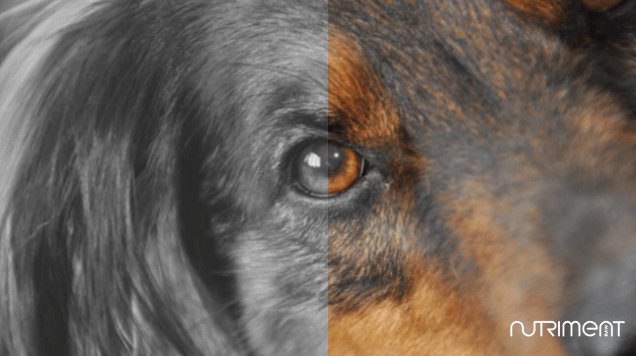Are Dogs Colour Blind?

Are dogs colour blind? It’s turns out the answer isn’t quite so black and white…
For a long time, people believed that dogs could only see in grayscale, but studies in the late 1980s dispelled that myth. Today, a dog’s vision is commonly described as ‘colour blind’.
Colour blindness in humans is a complex condition which can be inherited or acquired. Most people have colour vision that is trichromatic, meaning that they see the three colour variations (red, blue and yellow/green). There are lots of variations of colour blindness, of which one – known as dichromatic vision – is how dogs also see.
A closer look at the eye
The eye sees colour via a series of white light absorption and reflection. For example, blue objects absorb blue wavelengths of white light and reflect the rest. The reflected wavelengths reach the retina at the back of the eye. The retina contains two types of light-sensing cells: rods, which detect motion and vision in low light, and cones, which detect colours and provide details. The information received here is sent to the brain via the optic nerve, where we start to understand the objects and colour(s) we are seeing.
The non-colour blind human eye has around 6 million cones, of which there are three types: small (responding to blue colours), medium (responding to yellow / green colours) and long (responding to red colours). People with dichromatic vision (and dogs!) only have 2 types of cone: a blue-responding one, and one that is similar to the yellow / green one.
So, what colours can dogs see?
Now that the biology lesson is over, let’s see what this means for our pup’s perception…
Can dogs see colour? Yes, they absolutely can! The colours that are dominant in a dog’s colour vision are yellow and blue. Variations of blue, blue-green and purples all appear blue to your pup. Blue is such a strong colour for dogs, that it is recommended to always opt for blue toys to keep them engaged.
Shades of red and some greens will likely appear grey and brown to your dog, due to the lacking third cone. This means Christmas is probably quite dull for our four-legged friends!
The colour chart below gives us a rough idea of how our dogs see colour.

But colour isn’t everything!
Where their lack of colour vision may let them down, their sense of smell certainly makes up for it! A dog has 50 times more smell receptors in their nose than a human. This super strong sense of smell allows them to differentiate between objects that they may not be able to distinguish between by colour. To find out more about a dog’s sniffing superpower, read our blog post here.
Dogs also have a wider field of vision than humans (thanks to their wider eye settings) and have more rods (the cells that detect detail in low light) in their retinas so they can see better in the dark.
Did we answer your questions regarding can dogs see colour? Contact us here for more information or click here for start shopping raw food for dogs!




